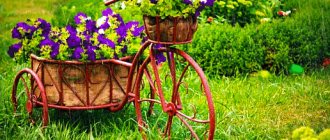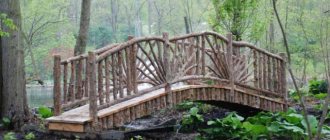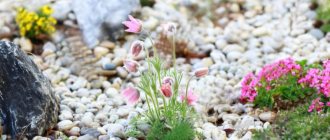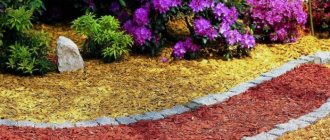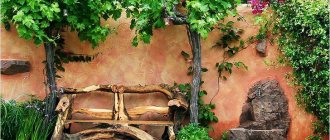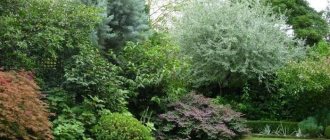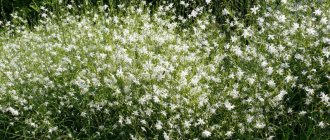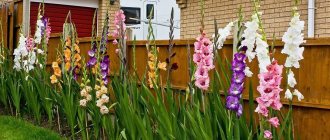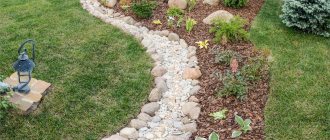Are you building a pond? Make no mistake!
Perhaps there is no point in convincing anyone that a pond in the garden is good.
Water attracts everyone’s attention like a magnet and even in photographs always looks mysterious and alluring. Is it any wonder that today a reservoir has become an indispensable attribute of the “gentleman’s set” of any design project for the development of a new land plot or the reconstruction of an old one?
Unfortunately, as a result of a formal approach to business, one garden becomes similar to another. Professional designers churn out gardens like they bake pies; they actually turn out cloned. To be honest, I am closer to the gardens of amateurs, who, although they are guilty of some amateurism, still attract more with their ingenuous soulfulness.
To make the path to beauty shorter, let's try together to analyze the characteristic mistakes that are surprisingly repeated in many bodies of water, and analyze their nature. And after that, we will step by step analyze all the subtleties and secrets of quickly, easily and economically creating a reservoir that is ideal for your garden. So, the most typical mistakes.
Place for a pond
This is the first thing to think about. Take into account the illumination of the area, the soil and topography, as well as the general style of the area being designed.
Water always attracts the eye, so the background for the pond should be attractive
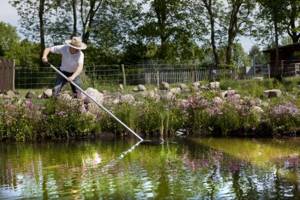
An old unsightly fence is not the best backdrop for a garden pond
Ideally, the area where it is planned to develop a pond should be illuminated during the day for no more than 6 hours. If the pond is constantly exposed to sunlight, this will inevitably lead to rapid growth of algae and water blooming.
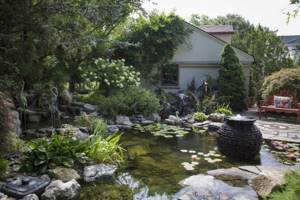
A beautiful pond can be built even on a small plot
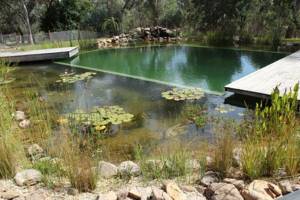
On a large area you can make both a pond and a swimming pool
When deciding on the soil and topography, give preference to the place that remains wet the longest after rain, let it be a lowland.
The pond simply must complement the overall style of the site, and not argue with it. Another important point: do not create a pond near tall growing greenery, as this will permanently be covered with a layer of leaves, seeds or flowers. In addition, tree roots can damage the foundation of the pond. So, such a neighborhood is not the best option.
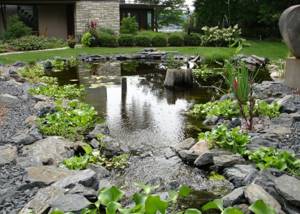
The location of an artificial reservoir depends on the purpose for which it is created
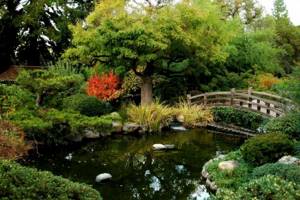
If the garden pond will be a decoration of the site, it should be located in the most visible place
Well, if your plans include a pond with live fish, then you need to make it as pleasant as possible for their habitat.
Another important detail: it is better if the pond is visible from the window of your house or from the gazebo in the yard. And if you place it at the entrance to the site, it will become a worthy business card. By the way, it wouldn’t hurt to think about what will be reflected in the mirror surface. Under no circumstances should these be outbuildings, otherwise the impression of the reservoir will be hopelessly spoiled.
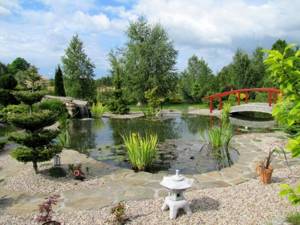
The pond fits perfectly into any landscape style
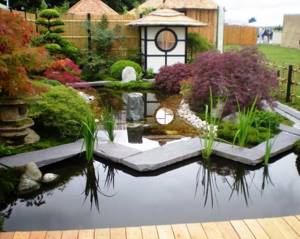
For a Japanese-style garden, a pond is its calling card
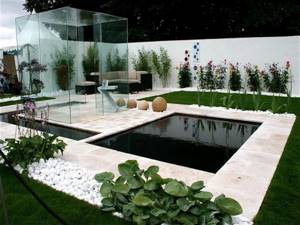
The pond looks no less attractive on a site decorated in a modern style.
Never stop there. Plan the location of the reservoir so that, if desired, you can easily expand it, or slightly change its shape. Leave some free space on at least one side.
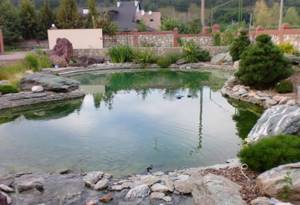
When designing a water feature, follow the law of similarity. For example, if there are stones on the site, then their texture and color must be repeated on the banks of the reservoir
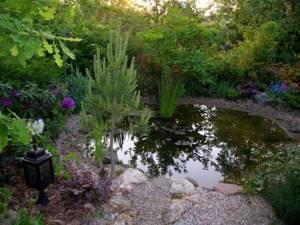
When decorating the banks of an artificial reservoir, do not overuse decor and accessories.
How to make a stream in the country? Main stages
First, let's decide what type of stream you want to create. The classic is running water that intricately meanders and crosses the entire site, going underground. However, it is worth considering that the stream can be of natural origin, and it can flow in a straight line. When you create an artificial stream, you yourself set the trajectory of the water flow. In this case, in order for the water to move, you will have to connect a pump. However, it should not be visible.
A simpler option is a dry stream where there is no water. This is a kind of stylized landscape element that just imitates running water. Now let's take a closer look at each option.
If there is a natural stream on the site, it usually does not present a very attractive sight: overgrown, with a swampy smell due to the low speed of water flow, which can sometimes even stagnate. First you need to examine it, see where the narrowest and widest places are.
Then you need to remove the weeds along the banks. Armed with a shovel, you can give the stream several bends and widen it in narrow places. By filling and deepening, try to increase its slope to give greater speed to the water. However, be careful with this.
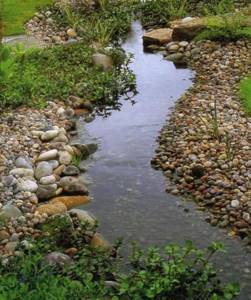
If the banks are very steep, try to make them flat and, if possible, slightly level the area near the stream by 2 meters in both directions. The stream should not resemble a ditch.
It is also necessary to clean the bottom of debris, and then lay pebbles and stones on it in random order, of different sizes. This will allow the stream to gurgle happily. You also need to put stones on the shore, burying them 1/3-1/2 into the ground.
The next stage is planting the plants. Moreover, try to select low-growing species, plant not densely, otherwise the stream will be lost behind lush vegetation.
Now let's look at creating an artificial stream. We take a plan of the site and plot its trajectory. It is very good if the terrain has a slope, because on a flat area you will have to form it by filling, and this is an extra cost. However, don’t worry, water can also run on almost flat terrain with a minimal slope, pumped by a pump.
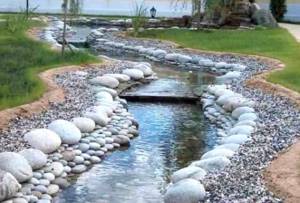
Then we begin to remove the stream into nature. It is necessary to dig a shallow groove (about 20 cm) with gentle banks. With a slope of 3 cm per 1 m, the flow of water will already be visible to the naked eye. It will also not be bad if you make one or more drops that will act as mini-waterfalls.
The bottom is compacted, and a special film is laid on it, which does not allow water to pass through. Make sure that there are no sharp stones, roots or other inclusions at the bottom that could tear the material. It is advisable to pour sand under the film in a layer of 5-6 cm (tamp).
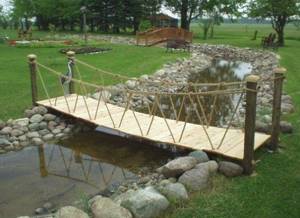
Instead of film, you can make a channel of concrete. While the concrete has not hardened, stones and pebbles are inserted into it. The disadvantage of this design is the need for shelter for the winter. Also, if all the water is not removed and it freezes, the bottom of the stream bed will become covered with cracks through which water will leak out in the summer.
If the slope of the bottom does not allow creating drops, then they can be made using large flat stones, which are laid at a slight slope in the direction opposite to the flow of water.
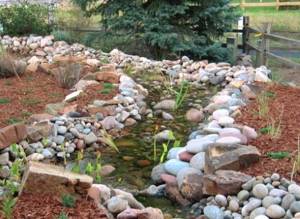
The stream will flow into a container (for example, an old bathtub) buried in the ground. On top it can be covered with a fine metal mesh, on which pebbles and stones are laid out (disguised). A pump is installed in the container, which will supply water through a hose to the source. The hose is buried in the ground.
To create a dry stream, you can use the technology discussed above, only without water. You can read more details here.
Waterfalls
Make a waterfall at your own discretion, but if there is at least a minimal difference in height on the site, then it would be a sin to miss this opportunity to make it even more alive and beautiful. You can organize the movement of water on a flat area - for this you will need to make a slight slope yourself. A waterfall in the garden is both a simply beautiful and functional element that connects different parts of the garden composition, enlivens the landscape, and becomes the central part of the recreation area. On a hot summer day, a pleasant coolness always blows from the smooth surface of the pond.
Types and materials
Materials for arranging a waterfall - film or concrete, sealant, pump, stones.
The height of an ordinary garden waterfall is usually up to 1.5 m. The greater the elevation, the more difficult it will be for the pump to pump water. If you want to make stone ledges, pay attention to sandstone - minimal processing is enough for it to blend harmoniously into the surrounding landscape. Main waterfall options:
- Calm, smooth flow - in this case, stones with recesses in the central part are used, which form reservoirs. As the containers fill, the water begins to slowly flow down.
- A solid water wall - it can be made by creating a perfectly smooth stonework from which water will fall.
- Separate jets - they are produced by stones with grooves and uneven edges, which will first need to be firmly cemented. It is advisable to limit the flow of water around the edges.
You can't make a waterfall without a slope. If the garden is located on a flat area, install an artificial hill. Purchasing a ready-made base for the slope will greatly simplify the work.
At the point where the waterfall falls, you can make a small lake, but if there is no outlet, it would be better to simply limit yourself to fragments of rocks that absorb the water flow. Designing a cascade always begins with determining the nature of the water pattern of the jet. The wider and higher the water jet, the more powerful the pump you will need.
Water supply
If you have a small but natural pond, the water supply issue is resolved - all that remains is to make a good pumping system. When there is no pond, an artificial reservoir is made, from which water is supplied for the waterfall.
Pump equipment
An inexpensive 80 W electric pump can handle the water supply for a waterfall about one and a half meters high; more impressive installations require powerful devices. The pumping station is installed on the bottom of the reservoir, hoses and cables are hidden during installation. The pump design has two pipes - one pumps and the second takes water (accordingly, the first is brought to the top of the structure, and the second is laid at the bottom of the reservoir). It is most convenient to connect the pump to a transformer and install the converter indoors. Use waterproof cables to connect the system.

The structure of the Japanese tsukubai bowl, which is relevant for
Japanese style in landscape design.
Lighting
Lighting the waterfall is not necessary, but it is advisable, since lighting gives this element of landscape design a special charm. Incandescent lamps, which are designed to work in an aquatic environment, have a power of 12 V, lamps come with 5-75 W halogen lamps. The lamp is attached to the support or directly to the walls of the water device. Floating ball lamps are lowered to the bottom or the required depth due to hanging weights. Sources with a power above 50 W are used only in water, since in air they overheat and can melt.
Filters
If the pond is not cleaned, it will quickly become a swamp. For cleaning to be effective, you need to:
- Install a filter.
- Ensure a constant flow of water through the pump.
The most effective are multi-stage filtration units, in which water is first disinfected and then passed through zeolite and sponges.
Design
It is advisable to think through the landscape design of a pond with a waterfall before the start of construction work, so that the source turns out organic and takes into account the features of further decor. Most often, ponds and cascades are decorated using decorative stone - it is affordable, looks neat, and prevents the active growth of weeds. The stones are laid out freely or cemented. Around the lake, be sure to plant plants that love high humidity - these are daylilies, saxifrage, ferns, and so on; water lilies and lilies look beautiful in the water.
Decoration
An artificial spring is a miniature water device. Its landscape surroundings should, when viewed closely, create the illusion of a natural origin. To do this, moisture-loving plants of small and medium shapes are planted nearby:
- viburnum;
- astilbe;
- fern.
If a regular design style for an artificial stream is chosen, then the source is designed in the form of a mascaron (a decorative element depicting a human face or an animal head in a grotesque or fantastic form) of a geometrically correct shape made of stones.
Decorating the flow of a stream involves decorating the banks and bottom of the riverbed. The shores are decorated with flat stones, large multi-colored pebbles, and boulders made of granite and slate. The stones are laid on tile adhesive, the space between them is filled with crushed stone or gravel.
Large stones are laid on the bottom of the riverbed in accordance with the design: to create mini-waterfalls, backwaters, and dams. The rest of the bottom space is covered with coarse-grained river sand and small multi-colored pebbles. A bridge/bridges across a stream (wooden or stone) will add completeness to the landscape. A variety of options gives you the opportunity to choose for every taste.
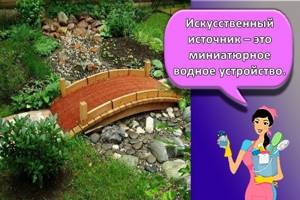
Option #3 – park fountains
A fountain is the only type of water feature that is initially man-made and has no analogues in nature. In addition to their decorative function, fountains also have a practical function, enriching the surrounding air with oxygen. When arranging suburban areas, jet and sculptural fountains are used.
Jet fountains are installed in ready-made reservoirs and are a sculptural part of the compositions. Sculptural ones represent an independent object of landscape design and often act as a key element of the garden.
When decorating small landscape gardens and “green offices” on the site, small sculptural fountains that are dug in look interesting.

A fountain in the shape of a girl with a jug with water flowing from the neck can decorate a secluded corner in the garden or the shore of a pond
Sculptural fountains represent a closed water cycle: in which the jets rise up or fall down under the pressure created by an electric pump. Although such miniature fountains have a small spread of water, they do not lose their special attractiveness because of this.
Wall fountains are ideal for decorating fences, external walls of gazebos and houses. When arranging such a fountain, the hoses and pump are hidden in the ground near the wall or hidden in the thickets of plants framing it.

Most often, wall fountains have the shape of the head of a bird, animal or mythical creature, from whose mouth streams of water flow
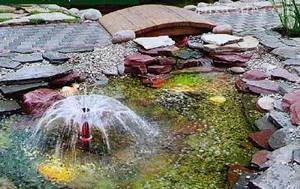
Jet fountains placed in reservoirs look most organic against the backdrop of plant compositions in suburban areas.
It can be a multi-jet fountain in the form of an umbrella, dome or geyser. The height of the jets and the type of water pattern depend on the chosen fountain nozzle and the operating characteristics of the pump.
How to properly design an artificial stream?
Depending on the type of material chosen for lining the riverbed, the construction technology will vary slightly. But the general rules remain the same. Carefully read the sequence of work to complete the entire volume as correctly as possible.
What materials should be prepared for the construction of an artificial stream?
- crushed stone
- priming
- broken brick
- sand
- ropes, slats
- wooden or metal rods
- concrete mortar, film or fiberglass
- polyethylene pipes
- pumping system
- hoses
- decorative materials
- plants.
Artificial stream construction technology
When designing an artificial stream, adhere to the following recommendations:
- Mark the bed of the stream.
- Use ropes, pegs and slats for this.
- Dig a trench, forming a channel according to the design.
- Create steps for the flow of an artificial source every 0.5-1 m.
- Clear the bottom of roots and stones.
- Tamp down well.
- Stretch a hose along the entire length of the riverbed.
- Attach one end to the pump, secure the other in the reservoir in the place where the stream flows into the lake.
- Make a sand cushion along the entire bottom with a layer of 3-5 cm.
- Tamp down thoroughly.
- Lay the film or concrete the bottom using plywood formwork.
- When using film, carefully level the canvas.
- Mask the hose installation site with flat flagstones or other stones.
- Carefully secure the edges under the turf that has been turned along the bank.
- Place the selected stones along the bottom of the stream.
- Run the water and check the stability of the pumping system.
- Decorate the stream with plants.
Decorative pond at the dacha - photos, videos, ideas
A decorative pond in a country house is a fashionable element of landscape design. And if maintaining a full-fledged pool is quite a troublesome task, then even the owner of a small plot can build a small pond.
The presence of a pond on a personal plot is determined not only by aesthetic considerations, but also by a practical component. On a hot summer day, even from a small body of water there is a breath of coolness, the air seems much cleaner and fresher.
The most popular types of artificial reservoirs in landscape design:
The shape of reservoirs on personal plots can be either round, with an irregular coastline, or regular geometric shape. It all depends on the location of the site, its features and your imagination. The main rule in this case is that the reservoir must ideally fit into the surrounding landscape.
The most common shape for an artificial pond is round or oval. This is exactly what natural lakes look like, so if you want to create a corner of nature in your garden, then this option will be the most acceptable. In this case, there may even be an irregular coastline and asymmetric planting of the reservoir with plants.
If the pond is located on an area where everything is done in a classic style, straight lines dominate, then a pond of the correct shape is built. Often, this is the basis for a fountain, which is the center of the exhibition.
It should be noted that the most common and least expensive in terms of labor and financial investments is a pond. But it is quite possible to arrange one on your site yourself without involving specialists.
Advice! Before you start arranging a decorative pond in your dacha, you need to decide on its purpose.
DIY decorative pond
A decorative pond in a garden can be small and shallow, because the most valuable thing about it is the aesthetic perception of the water surface surrounded by greenery and stones. Therefore, its arrangement may simply involve creating a waterproofing layer.
Having removed the soil and given the future pond the required depth, it is necessary to compact the walls well, after first pouring a layer of sand on them. If you plan to have a deep enough reservoir in which fish will be kept, so as not to risk the walls collapsing, they are made in the form of terraces going down to the bottom. This results in a more reliable structure that is not prone to landslides. And in horizontal areas it will be possible to place flowerpots with plants and decorative items for decorating the pond.
Any waterproof material can be used as waterproofing - polyethylene film, PVC fabric, roofing felt. It is important that this material does not deteriorate over time and humidity and can serve for a long time without accidents.
Having laid overlapping sheets of waterproofing, you need to make sure that in places where there is overlap, the layers are aligned and fit tightly to one another. This ensures that under water pressure they will not move anywhere and will hold it securely.
The edges of the film protruding over the sides are laid out and sprinkled with soil so that they do not curl up or move. In accordance with the design project, you can lay stones on them, or build an alpine slide on the edge of the pond, or place pots with above-water plants.
Decorative plastic pond at the dacha.
- easy to transport,
- easy to install
- withstands significant loads,
- washes and handles well,
- may have different sizes and shapes,
- small price.
This is the easiest and fastest way to make an artificial pond in your country house. Stores sell bowls of different shapes, sizes and colors (mostly blue, green and black).
When installing such a reservoir, you need to carefully ensure that its bottom is exactly parallel to the ground, otherwise the plastic container may crack.
In addition, you need to fill the plastic container with water gradually, while simultaneously pouring sand into the gap between the wall and the pit. Of the commercially available tanks, a plastic pond is the best option as it is rigid and durable, and is relatively inexpensive. You can design it as a natural pond, or you can make it the central object of a picnic area. Such a decorative pond can also be used as a small safe pool for children, especially since the plastic is dark in color and accumulates solar heat well.
Plastic pond care
Compliance with the basic rules of caring for an artificial reservoir will preserve its attractive appearance throughout the entire summer holiday:
- It is necessary to regularly remove plant leaves and small debris from the surface of the water.
- A net stretched over the surface of the pond during autumn leaf fall helps collect fallen leaves.
- Blooming, stagnation and unpleasant odor are prevented by a complete change of water in the decorative pond.
- The walls and bottom of the emptied plastic container are cleaned of deposits with a brush and rinsed with clean water.
- Aquatic plants grow very quickly; it is recommended to consult a specialist before planting them.
Capital construction
For adherents of good and solid solutions, capital structures are more suitable. In this case, a reliable structure is erected from concrete, which involves containing a significant volume of water. It can be used to create a recreation area in a summer cottage, or as a large fish pond.
One way or another, a decorative pond can be built without any help and in one season. The prepared recess is reinforced with reinforced concrete: reinforcement is laid along its walls and bottom, tying it at intersections or fastening it by welding. The finished structure is fixed with studs and a concrete solution is poured. The screed must harden completely, after which the entire surface of the pool is treated with sealant. The last stage is the design of the sides.
A decorative pond in a dacha is an important element of landscape design, the arrangement of which must be approached with the utmost seriousness! And then the beauty created by your hands will delight both you and your guests!
Sources: https://domoholic.ru/dekorativnyj-prud-na-dache/ https://domoholic.ru/dekorativnyj-prud-na-dache/ https://besedkibest.ru/obustrojstvo/yaponskij-sad/
Plants
Plants are an important part of the decorative design of a pond. All plantings that are used in landscape design can be classified into several categories
The choice of suitable plants is made taking into account the given style, climatic conditions and one’s own preferences.
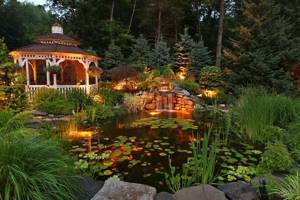
Shallow water
The shallow zone of the artificial reservoir is home to the most moisture-loving plants. Shallow plantings include perennials, which are valued for their picturesque beauty, density and original appearance. Various plantings are suitable for decorating a shallow area - from large plants to textured miniature specimens.
deep sea
Deep-water plantings are rooted at the bottom of the pond, and their leaves reach the surface of the water surface. The advantage of underwater plants with floating leaves is their ability to absorb organic components dissolved in liquid and negatively affecting the ecosystem. Large leaves of deep-sea plantings create shade and prevent strong heating of the liquid, which prevents active growth of algae. Most of the deep-water plantings are distinguished by beautiful flowering.
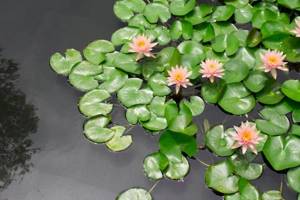
Coastal
The role of coastal plantings is solely for decoration. Such plants give the pond a complete look and harmoniously fit it into a single style. It is recommended to plant coastal plantings in baskets and dig in along the perimeter. Since plants grow quickly, you should not plant several specimens in one container so that they do not oppress each other.
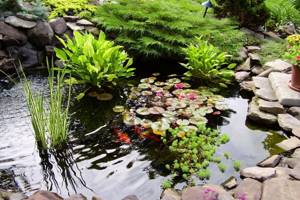
Decorative pond at the dacha - photos, videos, ideas
A decorative pond in a country house is a fashionable element of landscape design. And if maintaining a full-fledged pool is quite a troublesome task, then even the owner of a small plot can build a small pond.
The presence of a pond on a personal plot is determined not only by aesthetic considerations, but also by a practical component. On a hot summer day, even from a small body of water there is a breath of coolness, the air seems much cleaner and fresher.
The most popular types of artificial reservoirs in landscape design:
The shape of reservoirs on personal plots can be either round, with an irregular coastline, or regular geometric shape. It all depends on the location of the site, its features and your imagination. The main rule in this case is that the reservoir must ideally fit into the surrounding landscape.
The most common shape for an artificial pond is round or oval. This is exactly what natural lakes look like, so if you want to create a corner of nature in your garden, then this option will be the most acceptable. In this case, there may even be an irregular coastline and asymmetric planting of the reservoir with plants.
If the pond is located on an area where everything is done in a classic style, straight lines dominate, then a pond of the correct shape is built. Often, this is the basis for a fountain, which is the center of the exhibition.
It should be noted that the most common and least expensive in terms of labor and financial investments is a pond. But it is quite possible to arrange one on your site yourself without involving specialists.
Advice! Before you start arranging a decorative pond in your dacha, you need to decide on its purpose.
DIY decorative pond
A decorative pond in a garden can be small and shallow, because the most valuable thing about it is the aesthetic perception of the water surface surrounded by greenery and stones. Therefore, its arrangement may simply involve creating a waterproofing layer.
Having removed the soil and given the future pond the required depth, it is necessary to compact the walls well, after first pouring a layer of sand on them. If you plan to have a deep enough reservoir in which fish will be kept, so as not to risk the walls collapsing, they are made in the form of terraces going down to the bottom. This results in a more reliable structure that is not prone to landslides. And in horizontal areas it will be possible to place flowerpots with plants and decorative items for decorating the pond.
Any waterproof material can be used as waterproofing - polyethylene film, PVC fabric, roofing felt. It is important that this material does not deteriorate over time and humidity and can serve for a long time without accidents.
Having laid overlapping sheets of waterproofing, you need to make sure that in places where there is overlap, the layers are aligned and fit tightly to one another. This ensures that under water pressure they will not move anywhere and will hold it securely.
The edges of the film protruding over the sides are laid out and sprinkled with soil so that they do not curl up or move. In accordance with the design project, you can lay stones on them, or build an alpine slide on the edge of the pond, or place pots with above-water plants.
Decorative plastic pond at the dacha.
- easy to transport,
- easy to install
- withstands significant loads,
- washes and handles well,
- may have different sizes and shapes,
- small price.
This is the easiest and fastest way to make an artificial pond in your country house. Stores sell bowls of different shapes, sizes and colors (mostly blue, green and black).
When installing such a reservoir, you need to carefully ensure that its bottom is exactly parallel to the ground, otherwise the plastic container may crack.
In addition, you need to fill the plastic container with water gradually, while simultaneously pouring sand into the gap between the wall and the pit. Of the commercially available tanks, a plastic pond is the best option as it is rigid and durable, and is relatively inexpensive. You can design it as a natural pond, or you can make it the central object of a picnic area. Such a decorative pond can also be used as a small safe pool for children, especially since the plastic is dark in color and accumulates solar heat well.
Plastic pond care
Compliance with the basic rules of caring for an artificial reservoir will preserve its attractive appearance throughout the entire summer holiday:
- It is necessary to regularly remove plant leaves and small debris from the surface of the water.
- A net stretched over the surface of the pond during autumn leaf fall helps collect fallen leaves.
- Blooming, stagnation and unpleasant odor are prevented by a complete change of water in the decorative pond.
- The walls and bottom of the emptied plastic container are cleaned of deposits with a brush and rinsed with clean water.
- Aquatic plants grow very quickly; it is recommended to consult a specialist before planting them.
Capital construction
For adherents of good and solid solutions, capital structures are more suitable. In this case, a reliable structure is erected from concrete, which involves containing a significant volume of water. It can be used to create a recreation area in a summer cottage, or as a large fish pond.
One way or another, a decorative pond can be built without any help and in one season. The prepared recess is reinforced with reinforced concrete: reinforcement is laid along its walls and bottom, tying it at intersections or fastening it by welding. The finished structure is fixed with studs and a concrete solution is poured. The screed must harden completely, after which the entire surface of the pool is treated with sealant. The last stage is the design of the sides.
A decorative pond in a dacha is an important element of landscape design, the arrangement of which must be approached with the utmost seriousness! And then the beauty created by your hands will delight both you and your guests!
Wrong size
. A small puddle located somewhere near the fence or at the entrance to the garden and sandwiched on all sides by lush and beautiful garden plants, no matter how hard you try, will always look miserable.
The size of the reservoir must be correlated with the surrounding space
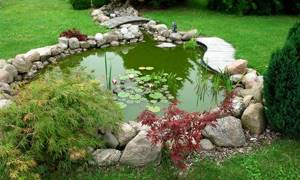
But this does not mean at all that a small body of water (for example, in the form of a spring) cannot decorate the garden at all. Simply by choosing this or that image, you need to correlate it with the surrounding space. If you don’t have room in your garden for a large pond, perhaps a selection of miniature ponds: a dozen simple ideas will help you find a solution. A successful example is also presented in the publication Saucer of Water as the completion of a dry stream.
Splashes aside!
A fountain is a good solution - it can be stationary or submersible, fills the air with natural oxygen and significantly increases the humidity around it. Used as an addition or stand out as an independent element of the garden. The strength of the spray and the shape of the water jet are adjusted using special nozzles. They can be in the form of a bell, a regular spray, a tulip or a regular pinwheel. So-called floating fountains and mascarons are gaining popularity - there is no limit to the perfection of landscape design.
Dry stream. Garden decoration in the spirit of the East
When arranging an artificial water stream, one principle is used: a pump pumps water from a reservoir located at the lowest point on the site to the highest point of the stream. After this, the water from the highest point flows down a natural slope.
If you plan to make a stream that would resemble a natural spring, then use the existing terrain. A water stream can go around garden sculptures and flower beds, flow near trees in the garden or recreation areas, creating small waterfalls, quiet pools, islands, or shallows. By respecting natural forms, you can achieve the naturalness of a stream.
Natural outlines of an artificial stream
Before you make a stream, think through all the details. For example, does the terrain allow for the creation of a waterfall? Is there a need for a second pond? Will it be a small stream or will it go around a decent part of the site? The longer the stream, the more equipment you will need to arrange it.
This is one of the original elements of the landscape. It's very easy to do
It will take a minimum of time and money to arrange the arrangement, which is important. A dry stream will decorate the garden plot, hide imperfections in the relief and visually increase the area around the house
Mosquitoes love to swarm over real bodies of water, but these insects have nothing to do near a dry stream.
If you properly arrange a dry stream, the effect from it will be no worse than from a water source. It seems like just yesterday crystal water flowed in it. It feels like a little rain will fill the stream with life-giving moisture, restoring life to it.
Dry streams are quite popular in China. They are the central elements of rock gardens, a symbol of water and continuous movement. In the East, a landscape is considered incomplete without water or its imitation. A dry stream is an excellent alternative for gardens where it is impossible to build a real pond.
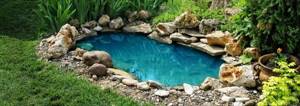
Japanese style stream
Some advantages:
- A dry stream harmonizes with any landscape design.
- Plays the role of a drainage ditch without the need to invest extra time, labor and money.
- Possibility of arrangement on hills and depressions, in the sun or in the shade.
- An artificial dry stream can be made in just a few days.
- There is no need to level the landscape, lower the relief or deepen the riverbed.
- There is no need to purchase a pump and accessories for pumping water.
- Possibility of planting any plants, not just moisture-loving ones.
A dry body of water must have a mouth and a source. As for the mouth, it can be hidden behind the large leaves of hosta, bergenia or other plants, while the source should be on a hill. Make a small depression, lining it with fine gravel. In this simple way you will create a semblance of a well, the illusion of a water source.
Decorative design of a dry stream
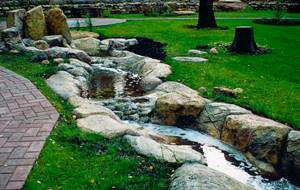
Arranging a stream with pebbles
Sand is perfect for marking the area. So, you can outline the contours of a dry body of water. A man-made stream may consist of several channels or just one. If you want it to look natural, then change its width in different areas.
To prepare the surface, remove the layer of turf and level the ground. You can use a regular garden rake for this. There should be a small depression (10–15 cm). Remember that an excessively concave rivulet looks unnatural.
Decorating a dry stream with boulders
Decorative elements will help you effectively design a dry stream. This could be, for example, a decorative bridge spanning a stream, etc.
Ponds in landscape style
The opposite of a regular garden is considered to be a landscape garden, which is especially loved by our compatriots. Closeness to nature - the natural habitat and the absence of prevailing rules - is what we are most often accustomed to embodying in our garden plots. The pond design favored by Russians is usually close to its natural shape.
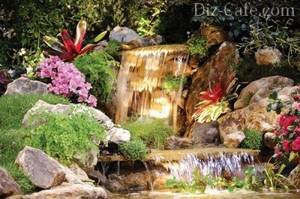
Landscape-style ponds are often complemented by babbling streams, picturesque waterfalls and cascades: everything together looks very attractive
Article on the topic: Landscape style in landscape design and its features
Such ponds can be seen in Japanese and Chinese styles, in English classical gardens, and in German landscape gardens (Naturegarten). Free contours, subordinated only to the natural landscape of the area, have their own charm. Neighboring them are babbling streams and waterfalls living their own special lives. The garden becomes a well-kept, but natural corner of nature.
Densely populated Chinese pond
A Chinese garden, as a rule, occupies a vast area, and there are several ponds in it. If the garden is small, then the pond matches it in size. But the presence of stylized bridges made of stone or wood across such a body of water is considered mandatory.

The Chinese pond makes us think about how abundant the nature around us is, how diverse the life it has given rise to
Ponds in China are not empty. Not only are they surrounded by lush vegetation, but equally active life is in full swing both in the reservoir itself and on its surface. The water is home to silver crucian carp or koi carp, and the surface may be attractive to mandarin ducks. A nice gazebo in the national style completes the picture.
Japanese pond frightening deer
Water is not present in every Japanese garden, because island Japan already has problems with land. Private gardens here are usually small. A full-fledged pond is replaced by stone pools with water. Sometimes there is so little space that a stone bowl of water plays the role of a reservoir in the garden. It is called tsukubai and is made in the form of a barrel for washing hands during the tea ceremony. As a rule, the container is illuminated with a special flashlight.
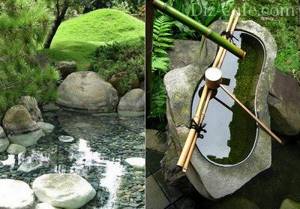
Depending on the space allocated for the Japanese garden, the pond may look one way or another: in any case, it is guaranteed a special Japanese flavor
At the edge of a Japanese pond there is another amazing decorative element - shishi odoshi (scaring deer). This is a kind of water pipe made from a hollow bamboo stem through which water runs. The purpose of the watercourse is fully reflected in its name.
England: echo of the colonial past
Far Eastern natural gardens, which once captured the imagination of colonialists from England, found a unique embodiment in their native lands. This is how the landscape design of decorative ponds appeared and took root in England. It was here that this style reached its heyday and recognition.
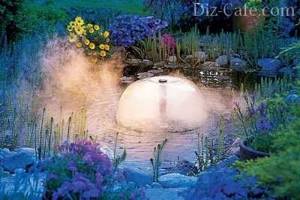
An English-style pond can rather be called landscape than natural, so carefully selected are the plants that are planted along its banks
English ponds are the embodiment of naturalness, surrounded by cultivated moisture-loving plants. Typically, reservoirs are complemented by colorful cascades and waterfalls.
Natural German garden
A distinctive feature of the German pond is the vegetation on its banks. These are usually wild plants, not garden plants. Ponds designed in this way look surprisingly attractive and as natural as possible.
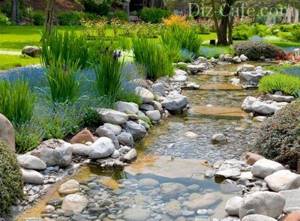
The Naturegarten style, characteristic of a pond in a German garden, is characterized by a selection of plants planted along the banks of the pond. They are literally the same ones that grow behind the fence, but that’s what makes them so special.
Making a dry stream with your own hands: step-by-step creation instructions
Before you form a dry stream in your dacha with your own hands, you need to think about what the shape of the future decorative fragment will be.
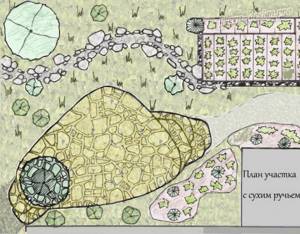
An example of a sketch of a site with a dry stream
You can draw up a standard drawing, look for interesting options on the Internet, or come up with your own, exclusive design. You can make a dry stream with or without a bridge, the main thing is to consider many options and choose the most appropriate one for the overall style of the garden area.
Also think about how many streams there will be. After all, you can make a direct flow or divide it into several additional directions.
Choosing rocks for a stream
When you have a visual idea of the future product, you can move on to choosing stones. To imitate water flow, it is better to use dark-colored pebbles with a smooth structure. Light shades are used to form thresholds.
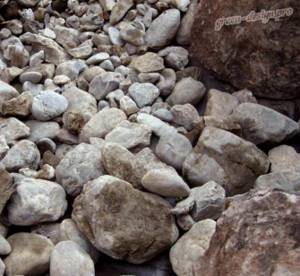
If you are planning a light blue composition, then give preference to gneiss, slate or basalt. Granite stones of the corresponding color will look appropriate in greenish, brownish or red shades.
The placement of light-colored accents is done with white marble or limestone. To create an original shimmering effect, glass balls are scattered between the stones. Such components will add lightness and mystery to the composition.
Choosing plants to decorate a dry stream
To make the stream look natural and original, be sure to surround it with beautiful garden flowers. Miscanthus, Chinese reeds, and leafy bamboos are perfect for growing in the Japanese style. Flowers in blue shades - lobelias, bells, forget-me-nots, irises, mosquito grasses - can also organically complement the compositions.
An original solution would be to plant multi-tiered flower beds from different crops, which will only complement the feeling of a living stream.
How to make a dry stream: stages of creation
Anyone can create a dry stream in the garden with their own hands, the main thing is to follow all the instructions for creating it. Having decided on the main points, formed a sketch, and selected stones, you can proceed to the formation of a decorative element. Now we have to lay the stones according to the prepared contours. To draw lines, use sand, string, hose, or something else.
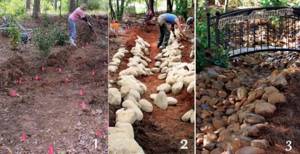
- Dig a hole in the ground along the intended contour, removing a 12-30 cm layer of soil. Level the surface of the “pit” using a rake. Place non-woven material on the bottom that will allow air and moisture to pass through well and prevent the appearance of weeds. Geotextiles or lutrasil are excellent. An alternative solution is a concrete layer or polymer film. You can sprinkle the film with earth or sand on top.
- Lay the stones, starting manipulations from the “shores”. Use cobblestones and rubble to support the inner edges, and place pebbles to secure the crevices. Small pebbles are laid in the bed of stone ponds.
- Having formed the “banks” of a dry stream, you can proceed to the designation of the “bed”. Now you can lay out miniature stones - pebbles or crushed stone. The final stage is planting and arranging the plants.
As you can see, a dry stream in landscape design with your own hands is easy to create and requires a minimum of financial and power costs.
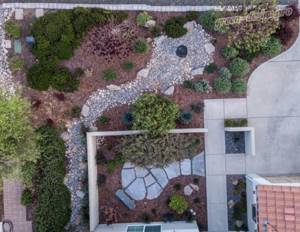
Water in garden design – spectacular ideas
Water always has a charming effect on people. Therefore, the successful integration of water features into the overall picture of the garden is rightfully considered one of the important disciplines in landscape design. Even the most beautiful garden gains significantly in charm if a fountain, a picturesque pond or an elegant swimming pool is skillfully integrated into its space. Jörg Baumhauer, co-founder of the German magazine “Der Schwimmteich” (Swimming Pool) and author of numerous publications, describes examples of solutions from various landscape designers on the way to creating the ideal water garden.
Water is diversity
The delight with which people talk about ponds, fountains or streams in their gardens is clear evidence of how great is the human connection with this element - and how great is the desire to recreate a piece of wild nature in the garden. There are many ways to harmoniously integrate water into the design of our gardens.
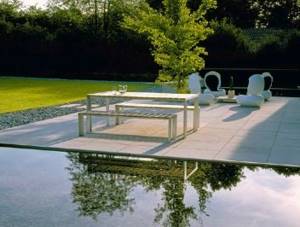
Shaping
What type of water feature will fit harmoniously into the garden depends mainly on the prevailing shapes, lines and style of the garden. A garden with regular geometric shapes is unlikely to be suitable for a natural pond with free outlines, and vice versa, a pond with clear lines will be inappropriate in a natural garden. It is the choice of one form or another that determines success or failure. A decorative water element that does not fit into the overall concept of the garden will always be a “foreign body” in the garden design and will not radiate the charm that is inherent in water. An important point at the planning stage of a water structure is not only its shape, but also its further use. The choice is great, since different forms of the water element can be combined with its use in different ways if desired. Therefore, for every taste and every style of garden, you can find a suitable water feature.
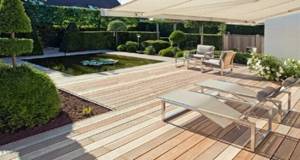
Design by Iris & Patrick Dryepondt, Belgium. Garden "Kragenhof", Iris & Patrick Dryepondt, Belgium.
Benefits of water
Many people believe that water features in the garden should be useful. If this is a garden pond, then fish should swim in it, in particular, Japanese koi carps, which have been popular in recent years. Having gotten used to it a little, the scaly friends will become so trusting that they begin to take food from their hands. A classic swimming pool has, of course, become a standard and at the same time useful element in the garden. Modern technologies and building materials make it possible to adapt it to the individual characteristics of the site and user requirements. Meanwhile, in recent years in Europe, swimming ponds have been giving them strong competition.

Swimming eco-pond – for all occasions
The only serious competitor to the pool, fighting for a special place in garden design, is the swimming pond. Thanks to the imagination and ingenuity of enterprising gardeners and enthusiastic nature lovers, a new type of usable decorative water feature has emerged that did not exist in nature, at least until the 1980s. In those days, swimming pools were considered the embodiment of bourgeois culture and were characterized by a lack of imagination. There was a fairly limited range of shapes and colors, and naturalists and nudists craved the pleasure of swimming in natural bodies of water, which satisfied their need for closeness to nature more than artificially created pools treated with ozone or chlorine. Pioneers in the field of creating swimming ponds took advantage of this unity with nature and began to look to natural bodies of water to explain why water is so pleasant to the touch and people love to swim in it. A lot of energy was spent, it was necessary to use all the knowledge from the field of limnology and botany, until they came to the conclusion that high water quality helps to maintain aquatic plants submerged under water, floating on the surface or growing along the banks, not to mention the main advantage - swimming ponds do not require the use of chemicals, and the water in them is much softer and more aromatic than chlorinated water. Ecoponds, like other natural bodies of water, quickly filled with life: the new form of swimming pools in the garden was loved by salamanders and frogs, water striders and dragonflies.

Landscape designer Hans de Vree, Holland. Garden "De Carishof", Hans de Vree & Henk Govers, Holland
Clear forms
The natural shape of the pond - size does not matter in this case - is characterized by smooth curves of the banks, decorated with lush vegetation. However, such a primitive form of a pond does not fit into any style of garden design. In a formal garden with clear geometry, it completely loses its appeal. Here it would be more appropriate to organize a pool of the correct geometric shape. Conversely, a pool of strict outlines, subject to all the rules of geometry, will not fit into a landscape garden. This means that the choice of the shape of a pool or small pond largely determines the success or failure of the entire endeavor. For most people, the word “pool” automatically implies a regular geometric shape.
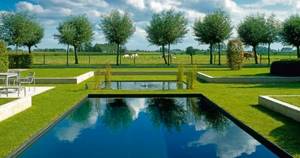
Landscape view
The main themes of creating "moving water" are taken from nature. Any wanderer or nature lover will hardly be able to pass by the magical gurgling of a spring or the joyful murmur of a stream. The natural appearance of the stream is given by the meanders of its bed, small waterfalls or cascades and a source hidden in the thickets. The skillful arrangement of plants, even along a relatively straight stream bed, creates a certain dynamics, allows you to achieve a harmonious decorative effect, in contrast to formal channels, which are deliberately given strict forms, and the elegant decorative effect of which is achieved through the use of appropriate materials and giving the correct geometric shape. Its location plays a big role in choosing plants to decorate a natural stream. If the stream dries up from time to time because only waste or rainwater flows through it, then, naturally, underwater plants will be out of play here. However, for a stream in which the water constantly gurgles, plants submerged in water or floating on the surface are perfect. But all these plants will not be enough for a spectacular design. Lushly flowering plants planted along the banks and a path in the form of a row of moss-covered stones passing through the stream, with their magnificent colorful spectacle and pleasant calming rustle, turn such a natural water element into a real attraction of the garden.
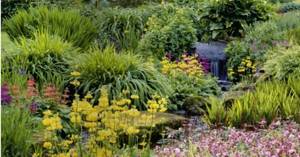
Trengwainton Garden, UK
Water channels in thickets of plants
To enhance the decorative effect of formal streams, their borders or banks are designed in the same style and from the same material that was used in the construction of the stream itself. A formal stream or canal has a clear, regular shape, and a variety of plants give a natural appearance to its bed. The material used in the construction of the cascade should, at least in the form of a hint, be reflected in the design of the shore. A successful combination of materials will further enhance the impression of the beauty of moving water. The design of the shore largely depends on the speed of the water flow. Fast-moving waters require stronger banks than small, slow-moving streams. Therefore, the walls and bed of a fast-flowing canal must be lined with stone and securely secured. The rapid flow of water in a natural stream leads to erosion of the banks, and with it, soil erosion. The choice of plants for decorating a canal or stream depends not only on the style of the garden, but also on the requirements of the plants for the habitat. Not all plants can easily tolerate continuous movement of water or constant drops on the leaves. Water lilies are especially sensitive in this regard. Therefore, it is advisable to design a formal stream or canal with a fast flow, placing plants not in the water, but along the banks, giving the water feature a clear outline with the help of plants.
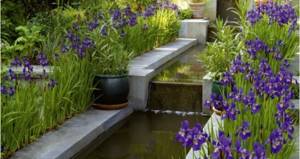
Design from German landscape designers. Weisser family garden (Weisser), Germany.
Chain murmur
Fountains and small ponds made in a traditional style will not become obsolete for a long time, however, modern materials and sophisticated technologies open a wide way for new original solutions in the field of garden design.
What do you think is shown in the photo: a pool, a fountain or a cascade of fountains? Or maybe it is a mixture of all three forms of a decorative water element? No matter what decision you come to, this successful example demonstrates how diverse the possibilities of using water in landscape design are. Water flows down long, almost transparent chains, forming a water surface, and if you look at it, it seems that it is swaying from one chain to another. Sunlight, reflected by many small rays in the chain links and calm water surface, only enhances this stunning effect. The culmination of this play of light and water is also its end: a cylinder located at the end of the chain accelerates the movement of water and directs its more or less uniform flows onto the stones. And before the water disappears into the narrow crevices of the wrinkled gravel, it again demonstrates its play of light and shadow on the smooth, wet surface of the stones. Amazing sight!
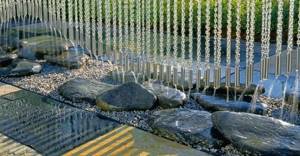
Design by Jane Mooney, UK. International flower exhibition “Hampton Court Palace Flower Show”, UK.
Vegetable world
When we talk about a water garden, we inevitably mean a range of aquatic plants. Of course, there are types of water features in which aquatic plants play a minor role or are not important at all. These primarily include fountains, formal ponds and swimming pools. Of course, this is not the rule when it comes to arranging a water element in a natural style, since submerged underwater, floating on the surface or marsh plants are considered a clear sign of a reservoir that imitates natural in appearance. And even adherents of formal ponds are often reluctant to abandon design solutions that involve aquatic plants.
Design by German landscape designers Liat & Oliver Schurmann. International flower exhibition “Hampton Court Palace Flower Show”, UK.
When talking about plants for water structures, we mean a group of helophytes (plants that live on soils saturated with water), hygrophytes (plants that live in conditions of high soil and air humidity) and hydrophytes (aquatic plants that freely float or take root at the bottom of a reservoir and completely submerged in water). All of them are perfectly adapted to the aquatic environment and quickly get used to its unpredictability - be it fluctuating water surfaces, a waterfall, or people relaxing near the water.
The curved outline gives this formal creek a natural look. The striking stone-paved walls of the stream support this effect and lead the viewer's eye from the source to the mouth, without distorting the impression of the graceful design of the garden (design by Frank Diederich, Germany).
Some plants have adapted to underwater life thanks to different leaf shapes. For example, the water buttercup (Ranuncufus aquotilis), with its feathery, soft leaves, is unlikely to resist the flow of water, so it may well colonize a slow-moving stream. The large surface area of buttercup leaves is able to absorb sunlight even in deeper bodies of water. However, underwater plants do not grow well in turbid waters, since without light photosynthesis does not occur and the plants starve. High levels of phytoplankton (turbid water) cause great harm to underwater plants. Plants submerged under water are recommended for use in ponds, where they perform not only a decorative, but also a practical function. Their role is especially great in ensuring the life of aquatic animals in winter. The less oxygen that evergreen underwater plants produce during photosynthesis in a body of water, the worse the water quality will be in the spring, and the less likely aquatic animals will be to survive in such water.
From Jörg Baumhauer's book “Wasser im Garten” (Water in the Garden)
Translation: Lesya V. especially for the gardening internet portal
Making a dry stream with your own hands
When there is no doubt and the decision is made in favor of a dry reservoir, you can begin to implement it. To do this, you need to choose a place and decide on the necessary materials.
First of all, it is necessary to outline the contour of the future stream and dig a hole equal to 15-25 cm along its perimeter. To prevent the growth of weeds, it is better to cover the bottom of the future reservoir with any covering material. For this, dark-colored geotextiles or non-woven material that allows moisture to pass through are suitable. This simple measure will protect you from annoying weeds that can significantly spoil the appearance of your masterpiece.
Next, you can fill the reservoir with the necessary materials: sand and various types of stones. For laying, several types of stone are taken at once, as a rule, these are pebbles, pebbles and rubble. Rubble is used to strengthen the edges of the stream, pebbles mixed with sand fill the stream bed, and cracks are filled with bare stone.
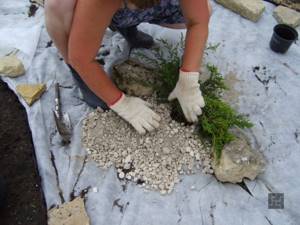
The main thing to remember is that the dry stream came to us from Japan. And this is a country where brevity and moderation are valued. After constructing the stream, it needs to be decorated. Proper arrangement of plants will help with this. Here it is better to take those species that are associated with water, but can grow on ordinary soil. When decorating, as when organizing the stream itself, you need to know when to stop: do not allow your pond to turn into an ordinary flower garden. Plants should only emphasize beauty, but not become its main element.
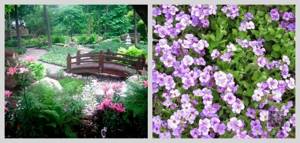
Avoid using tall plants, but bluish-gray or blue colors work best (bells, blue fescue, creeping grass, mosquito grass and others).
Option #4 – artificial ponds
The main feature of ponds is the static stillness of the water, in which, as if in a mirror, the seasonal changes of the plants framing the pond are reflected.
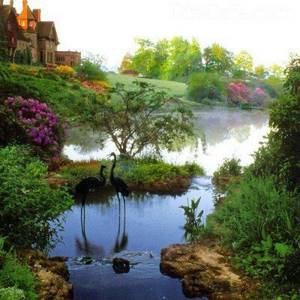
The smooth surface of lakes and decorative ponds attracts attention with the deep blue and multicolored iridescent reflection of flowers
Among the variety of designs for garden ponds, the most attractive are those with simple natural shapes and an uneven outline, making it impossible to take in the entire landscape.
The shorelines of decorative ponds are made as naturally as possible so that the pond fits harmoniously into the surrounding natural landscape.
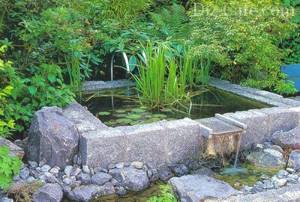
When designing small areas, raised ponds arranged in autonomous containers or high flower beds look interesting.
Decorate the shore of the pond with boulders or small stones, decorate it with coastal plants and lighting - and it will become a real decoration of your garden.

The decorative pond is unusually beautiful in the evening, when its mirror-like surface reflects the dark crowns of the trees in the garden, a rich palette of heavenly colors and the flickering lights of street lamps
